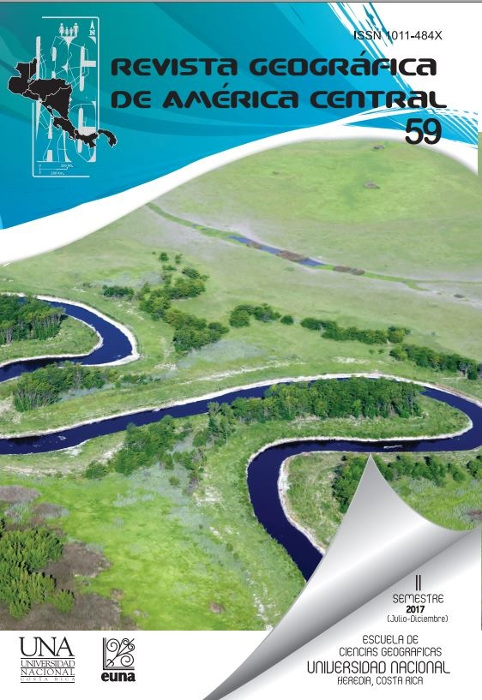Los diferentes datum y proyecciones cartográficas de Costa Rica: generalidades y relaciones
DOI:
https://doi.org/10.15359/rgac.3-59.2Palabras clave:
datum Ocotepeque, datum CR90, datum CR98, datum CR05, proyecciones de Costa RicaResumen
En Costa Rica se han implementado y usado una serie de proyecciones cartográficas desde la segunda mitad del siglo XX. La primera cartografía oficial del país, que funcionó durante varias décadas, estuvo basada en una proyección conforme de Lambert con dos paralelos de contacto. Con base en este sistemas cartográficos se definieron las denominadas las denominadas zonas norte y sur. Esta cartografía nacional consideró como superficie de referencia el elipsoide Clarke 1866, y como marco de referencia las coordenadas de los puntos provenientes de las cadenas de triangulación. A inicios de la década de 1990, se desarrolló un proyecto que tuvo dentro de sus objetivos primordiales dotar al país de una nueva red geodésica, basada en el posicionamiento satelital por medio de GPS. Las coordenadas ajustadas de los vértices de esta red referidas al elipsoide WGS84 constituyeron la base del llamado datum CR90, cuyos datos se usaron en la generación de cartografía en proyección CRTM90. A finales de esa década, un proyecto de investigación desarrollado en la Escuela de Topografía, Catastro y Geodesia (ETCG) reunió las mediciones GPS de varios proyectos nacionales y realizó el primer ajuste de una red geodésica costarricense dentro del Marco Internacional Terrestre de Referencia (ITRF) del año 1994, dado a la época 1998,35 (Dörries y Roldán, 1998) y (Dörries y Roldán, 2004). Este nuevo datum se denominó como CR98, al cual se asoció la proyección CRTM98. A mediados de la década de los años 2000, se realizó la medición de otra red geodésica nacional dentro del ITRF2000, la cual constituye la base del datum oficial de Costa Rica, denominado como CR05 y la correspondiente cartografía oficial en proyección CRTM05. Las diferentes redes geodésicas que se han medido en Costa Rica y sus correspondientes proyecciones cartográficas implican que se cuente con una gran cantidad de información geoespacial, de la cual es fundamental conocer sus metadatos en aras de poder proyectarla al plano correcto o poder transformarla de manera adecuada. Si bien es cierto, para muchas de las aplicaciones prácticas la escala de trabajo no permite visualizar un efecto directo en el producto cartográfico, es indispensable el manejo adecuado de la información.
Referencias
Costa Rica. (2007). Decreto ejecutivo 33797-MJ-MOPT. Ministerio de Justica y Gracia. Costa Rica.
Dörries, E. y J. Roldán (1999). Estudio Comparativo del Datum Geodesico de Ocotepeque y el Datum Satelitario del Sistema WGS84. Informe Final Proyecto de Investigación. Escuela de Topografía, Catastro y Geodesía. Universidad Nacional.
Dörries, E. y J. Roldán (2004). El Datum Geodésico de Ocotepeque y el Datum Satelitario del Sistema WGS84. Revista UNICIENCIA, 21(1 y 2), 117-125.
Grosmann, W. (1976). Geodätische Rechnungen und Abbildungen in der Landesvermessung. Verlag Konrad Wittwer, Stuttgart.
Grafarend, E., R. You y R. Syffus (2014) Map Projections Cartographic Information Systemns. Second Edition. Springer-Verlag Berlin Heidelberg. DOI 10.1007/978-3-642-36494-5
Hooijberg, M. (1998). Practical Geodesy Using Computer. Springer-Verlag Berlin, Alemania.
Hooijberg, M. (2008). Geometrical Geodesy Using Information and Computer Technology. Springer-Verlag Berlin. Alemania
Hoffmann-Weelenhof, B., H. Lichtenegger y E. Wasle (2008). GNSS Global Navigation Satellite Systems GPS, GLONASS, Galileo & more. Springer Wein, New York. Estados Unidos.
IAGS. (1950). Proyección Lambert Para Costa Rica. InterAmerican Geodetic Suvey, Estados Unidos de América.
ILIS (1988). Catastro Multifinalitario Programa de Mejoramiento del Catastro Nacional. Reino de los Países Bajos. Dirección General para la Cooperación Internacional (DGIS).
Jekeli, C. (2006). Geometric Reference System in Geodesy. Division of Geodesy and Geospatial Science. School of Earth Sciences. Ohio State University.
Leick, A. (2004). GPS Satellite Surveying. Editorial Wiley. Tercera Edición. Estados Unidos. 464 pp. ISBN: 978-0-471-05930-1
Moya, J. y B. Cedeño (2017). Conceptos básicos en geodesia como insumo para un tratamiento adecuado de la información geoespacial. Revista Geográfica de América Central, 58(1). ISSN 1011-484X. 71-100.
Niemeier, W., J. Roldán, L. Aguilar, H. Pelzer, A. Bagge, W. Augath y W. Seifert (1993). The Project CORBAS - determination of recent crustal movements in Costa Rica. Recent Geodetic and Gravimetric Research in Latin America. IAG Symposium No. 111. Vienna Austria
Torge, W. (2001). Geodesy. 3rd. Edition. Walter de Gruyter-Berlin-New York. 416 pp.
Publicado
Cómo citar
Número
Sección
Licencia
Política propuesta para Revistas que ofrecen Acceso Abierto
Los autores que publican en esta revista están de acuerdo con los siguientes términos:
a. Los autores conservan los derechos de autor y garantizan a la revista el derecho de ser la primera publicación del trabajo, bajo la Licencia https://creativecommons.org/licenses/by-nc-sa/4.0/deed.es, que permite a otros compartir con un reconocimiento de la autoría del trabajo y la publicación inicial en esta revista.
b. Los autores pueden establecer por separado acuerdos adicionales para la distribución no exclusiva de la versión de la obra publicada en la revista (por ejemplo, situarlo en un repositorio institucional o publicarlo en un libro), con un reconocimiento de su publicación inicial en esta revista. Esos acuerdos adicionales deben respetar los términos de la licencia: es decir: no involucrar fines de lucro y compartir con la misma licencia.
c. Se anima a los autores a archivar el post-print o versión de editor/PDF en repositorios de acceso abierto.







 REVGEO se encuentra bajo la licencia https://creativecommons.org/licenses/by-nc-sa/4.0/deed.es
REVGEO se encuentra bajo la licencia https://creativecommons.org/licenses/by-nc-sa/4.0/deed.es
.svg_4.png)

_(1).png)
_(1)_(1)_(1)_1.png)
(2)(1)(1)(1).png)
